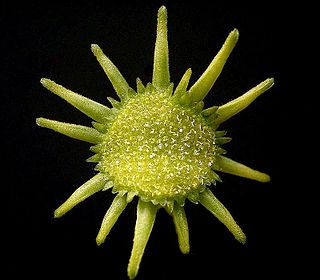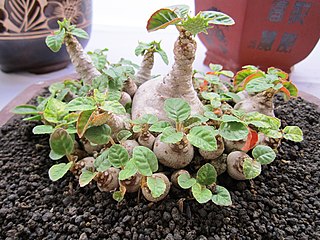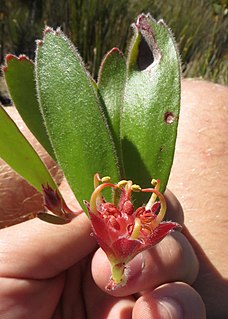
The Moraceae — often called the mulberry family or fig family — are a family of flowering plants comprising about 38 genera and over 1100 species. Most are widespread in tropical and subtropical regions, less so in temperate climates; however, their distribution is cosmopolitan overall. The only synapomorphy within the Moraceae is presence of laticifers and milky sap in all parenchymatous tissues, but generally useful field characters include two carpels sometimes with one reduced, compound inconspicuous flowers, and compound fruits. The family includes well-known plants such as the fig, banyan, breadfruit, mulberry, and Osage orange. The 'flowers' of Moraceae are often pseudanthia.
Pachypodium bicolor is a species of plant in the family Apocynaceae.

Pachypodium brevicaule is a species of plant that belongs to the family Apocynaceae.

Trilepisium, the urnfigs or false-figs, is a small Afrotropical genus of plants in family Moraceae. They grow to medium-sized or large trees that occur in evergreen and semi-deciduous forests, flooded forests or forest patches and often along rivers and streams, and at altitudes of up to 2,000 m and over.

Leucospermum cordifolium is an upright, evergreen shrub of up to 1½ m (5 ft) high from the Proteaceae. The flower heads are globe-shape with a flattened top, 10–12 cm (3.9–4.7 in) in diameter, and are carried individually or with two or three together mostly at a right angle to its branch. The perianth is 3–3½ cm long, yellow, orange or crimson in color. From each flower emerges a 4½–6 cm (1.8–2.4 in) long style sticking out horizontally but curving upwards near the obliquely, shell-shaped, thicker pollen presenter. This gives each head the appearance of a pincushion. Its common name is ornamental pincushion in English and bobbejaanklou in Afrikaans. It flowers between the middle of July and the end of November. It naturally occurs near the south coast of the Western Cape province of South Africa. Varieties and hybrids of this species are used as cut flower and garden plant.

Dorstenia is a genus within the mulberry family, Moraceae. Depending on the author, there are said to be 100 to 170 species within this genus, second only in number to the genus Ficus within Moraceae. Dorstenia species are mainly known for their unusual inflorescences and growth habits. Dorstenia is named in honor of the German physician and botanist Theodor Dorsten (1492–1552). The type species is Dorstenia contrajerva.

Dorstenia contrajerva is a plant species in the family Moraceae. It is native to Northern South America and Central America, and is cultivated elsewhere. The species name "contrajerva" is the Latinized form of the plant's Spanish name, "contrahierba," a name for plants used for treating poisoning and venomous bites and stings, and for which its rootstocks are used in folk medicine. It is the type species of the Dorstenia genus and was first described by Carl Linnaeus in 1753.

Clerodendrum infortunatum, known as bhat or hill glory bower, is a perennial shrub belonging to the family Lamiaceae, also sometimes classified under Verbenaceae. It is the type species among ~150 species of Clerodendrum. It is one of the most well-known natural health remedies in traditional practices and siddha medicine.

Leucospermum reflexum is a large rounded shrub that is assigned to the family Proteaceae. It grows from a single trunk and its branches are covered in smooth grey bark. It has small elliptic to inverted lance-shaped greyish leaves of only 2–5½ cm (0.8–2.2 in) long. The heads consist of mostly dark orange 4-merous flowers, from which long, identically colored styles emerge, which are directed straight down during flowering. It is called rocket pincushion or skyrocket leucospermum in English and perdekop in Afrikaans. It flowers from the end of August to December. It is an endemic species that can only be found in the southwest of South Africa.

Solanum evolvuloides is a species of Solanum, which was first described in 2011 by Giacomin & Stehmann. Solanum evolvuloides belongs to section Gonatotrichum, a small group assigned to the Brevantherum clade of the genus Solanum. It resembles Solanum turneroides Chodat, sharing with it heterandry, and Solanum parcistrigosum Bitter, with which it shares a similar habit and pubescence. Despite these similarities, the species can be recognized by its ovate-elliptic to cordiform leaf shape and more membranaceous leaf texture than the other species in the section, and stem, inflorescence axes, and calyx vestiture mainly composed of glandular hairs. Solanum evolvuloides is known to occur only in southeastern of Bahia state, Brazil, and in a preliminary assessment of the International Union for Conservation of Nature (IUCN) criteria can be considered a threatened species.

Dorstenia foetida is a succulent plant in the genus Dorstenia, which is native to Eastern Africa and Arabia. It is a very variable species with a wide distribution.

Trilepisium madagascariense, the urnfig or false-fig, is a species of plant in the family Moraceae, with an extensive range in the subtropical and tropical Afrotropics. It grows to a medium-sized or large tree in primary or secondary forest, or in forest patches, and is rarely cultivated.

Zanthoxylum humile is a dense, deciduous Southern African suffrutex to 3 m tall and a member of the family Rutaceae. It occurs in KwaZulu-Natal, Mpumalanga, Kruger National Park, Limpopo Province, Mozambique and the southern part of Zimbabwe.

Dorstenia indica is a small plant species in the family Moraceae native to Southern India and Sri Lanka. It was first described by Robert Wight in 1853.

Leucospermum hamatum is mat-forming, evergreen shrublet of only about 10 cm (3.9 in) high, from the Proteaceae. It is usually 1–3 m (3.3–9.8 ft) in diameter, has long trailing stems and upright, inverted lance-shaped, entire leaves but for one to five shallow reddish bony teeth near the tip. Its small flower heads of 1½–2 cm (0.6–0.8 in) in diameter, consist of four to seven drab carmine-colored flowers that strongly curve back to the centre of the head. It mainly flowers from July till November and is pollinated by mice. It has been given the common name Ruitersbos pincushion.

Leucospermum gueinzii is an evergreen, upright shrub of 2–3 m (6–9 ft) high from the family Proteaceae. It has pointy lance-shaped to elliptic, eventually hairless, mostly entire leaves and egg-shaped, later flatter flower heads of about 12 cm in diameter, containing initially deep orange, later crimson flowers. From the center of each flower emerges a long style with a thickened tip, giving the entire head the appearance of a pincushion. Its flowers can be found between August and December. It is called kloof fountain-pincushion or shorter kloof pincushion in English. This is an endemic species restricted to a very small area near the south coast of the Western Cape province in South Africa.

Leucospermum secundifolium is a low, evergreen shrub that grows along the ground, the tip of the branches slightly rising, which ihs been assigned to the family Proteaceae. It has narrowly elliptic leaves with a distinct leafstalk, and few-flowered and very small heads of 1–1½ cm (0.4–0.6 in) across. It is called stalked pincushion in English. The sweetly scented flower heads may be found around early December. It is an endemic species that only grows in a small area of the Western Cape province of South-Africa.

Mimetes saxatilis or limestone pagoda is an evergreen, upright, rarely branching shrub of 1–2¼ m high, assigned to the family Proteaceae. The approximately oval leaves are 3½–5 cm (1.4–2.0 in) long and 1½–3 cm (0.6–1.2 in) wide with a blunt, thickened, reddish tip or with three crowded teeth. It has cylinder-shaped inflorescences topped by a crest of green leaves, further consisting of heads with 12-22 individual bright yellow flowers, each in the axil of a flat, green leaf. It is an endemic species that is restricted to limestone outcrops in the Agulhas plains in the very south of the Western Cape province of South Africa. It is considered an endangered species. Flowering may occur between July and December, but is unreliable in its timing, dependent on sufficient moisture availability.

Prunus himalayana, called jyokun shin in Tibetan and 喜马拉雅臭樱 in Chinese, is a species of Prunus native to Nepal, Bhutan, Sikkim and Tibet. It prefers to grow 2,800 to 4,200 m above sea level in the Himalayas. As Maddenia himalaica it was the type species for the now unrecognized genus Maddenia.

Protea pendula, also known as the nodding sugarbush or arid sugarbush, is a flowering plant of the genus Protea, in the family Proteaceae, which is only found growing in the wild in the Cape Region of South Africa. In the Afrikaans language it is known as knikkopsuikerbossie or ondersteboknopprotea.


















